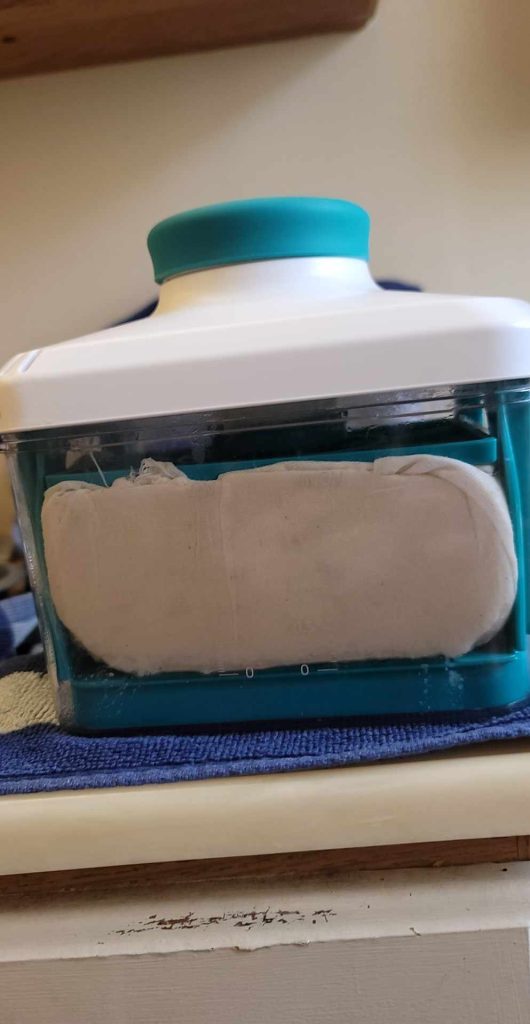LAB NOTES: NON-Soy Fava Bean Tofu

Hello All! Wayne AKA The Mad Food Scientist here.
Today I’m continuing my experimental series on Non-Soy tofu.
This time Fava beans are in the hot seat. When I originally started researching homemade Non-Soy tofu, I stumbled upon: Sam Lin of the Sam’s Home Kitchen YouTube channel ( LINK HERE: https://youtu.be/6N8KE4o4xMw ). In the video he made tofu out of lentils. Lentil Tofu happens to be the first type of non-soy tofu that I’ve made. Since then I’ve made tofu out of pumpkin seeds, chickpeas ( aka Garbonzo beans ), peanuts, split peas, and pinto beans, kidney beans, and Great Northern beans. I learned from Sam that any lentils can be used, not just red lentils as you’ll see posited in many videos from other creators. I also watched the Lentil tofu video from Mary at Mary’s Test Kitchen YouTube Channel ( LINK HERE: https://youtu.be/qUj7iyvi7dM ). I disagree with straining the slurry before cooking down which is one step that Mary does. I also don’t use a coagulant. Another thing that I deviate from Mary’s process is that I don’t let the slurry sit to settle out starch. The main reasons that I skip that step is to reduce wast-age and also, my lack of eyesight. More than likely, I’d scoop starch and not realise it. So, why waste time, just leave it be. One thing that I did take advantage of, was a suggestion from Mary. I bought her favourite tofu press. It isn’t really needed, however, it does make my experimentation easier. However, like Ms. Mary, I keep asking myself the question “Will It Tofu?”. So far, I’ve not had a failure. I’ve also used said press to help make a couple different vegan cheeses, and even turned vegan chickpea yoghurt into Vegan Greek Style yoghurt for use in making Tzatziki using this press. As I mentioned above, I’ll be making tofu out of Fava beans.
24 September, 2023 Fava Bean Tofu Experiment 01.
INGREDIENTS:
170g Fava Beans
680g water for soaking
680g water for the slurry
1 tsp baking powder
1/2 tsp sea salt.
EQUIPMENT:
1 Saucepan
1 Blender jar
1 Blender base
1 spatula
1 collandar
1 tofu press
1 Induction cooktop
Cheesecloth
METHOD:
Soak beans in water and baking powder
Drain and rinse said beans after soaking.
Put beans in the blender jar
Add 1/2 tsp sea salt
Add 680g water.
Blend for five minutes.
Pour slurry into a saucepan.
Bring to a boil, then drop to a simmer.
Simmer until slurry reaches desired consistency.
Stir CONSTANTLY to avoid scorching.
Dampen cheesecloth and place in the tofu press/mold
Pour the tofu into the press.
Fold the cheesecloth over the top of the slurry.
Fasten the lid to the press/mold.
Tighten it down and place in the refrigerator to chill/set.
LAB NOTES: 24 September, 2023
I began this experiment yesterday ( 23 September, 2023 ) when I
put the beans, the baking powder, and water into a mason jar and put it in my refrigerator.

The process went as per plan. I have other posts about making no-soy tofu that go into more
detail about the process. Once the slurry was up to a boil, I dropped the induction hob from 270C/518F to 80C/176F and stirred it constantly. The cookdown took twenty minutes after I dropped the heat. When it was done cooking down. I turned off the heat. I dampened cheesecloth and put it in the tofu press. I put the tofu into the mold, folded the cheesecloth over the top of the tofu and put the lid on and dialed down the platen to put pressure on the tofu.

I let it cool for a half hour, poured out the liquid that was expelled and put the press into the refrigerator.
LAB NOTES: 25 September, 2023
I left the press in the refrigerator for at least twenty four hours.
I poured off the liquid extracted, unwrapped the tofu from the cheesecloth and
weighed the results. The yield was 702g of Fava bean tofu.

The tofu was firm, it smelled nice. I tasted a bit that was stuck to the cheesecloth and it didn’t taste terrible raw. Then I triple wrapped the tofu in wax paper, cling film, and aluminium foil. This bundle was placed in the freezer. I’ll thaw it, then freeze it again. So that when I’m ready to use it and it thaws.
The tofu will soak up flavours more readily.
FINAL THOUGHTS: 01 OCtober, 2023
Please note: All prices listed are in USD.
Fava beans are rather expensive in my local store. $4.00/454g or $0.0088/g
So the 170g of Fava beans that I used costs out to $1.50. That in itself is not terrible. However, there are beans locally available that range in cost between $1.19/454g ( Green Split Peas, my go to for milk making ) and $2.50 ( Mayacoba ).
I’ll search online sources to see if I can find a better price for Fava beans. In the meantime, I’ll continue utilising beans that are more affordable. As mentioned above, there are more affordable
I would say this experiment, as all of my non-soy tofu experiments have been, was successful.
I suspect that I’m getting different results than Mary from Mary’s Test kitchen in her video series “Will It Tofu” because I’m not straining the slurry, not trying to remove starch from the slurry, nor am I using a coagulant.
Until next time: Go PLAY with your food!!